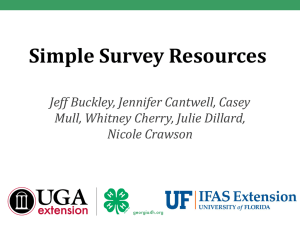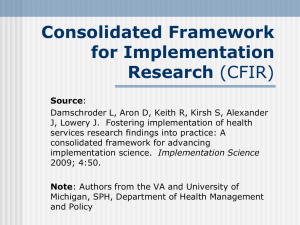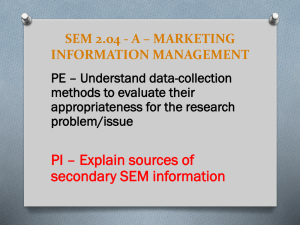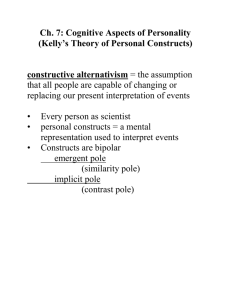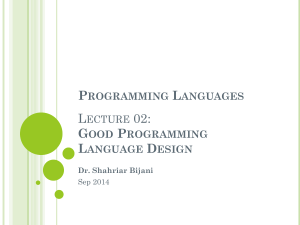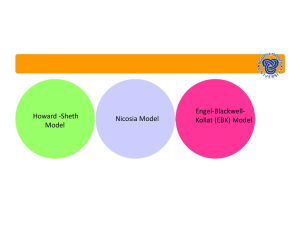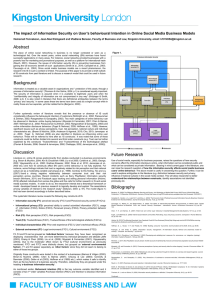Fostering Interdepartmental Knowledge Communication Through
advertisement
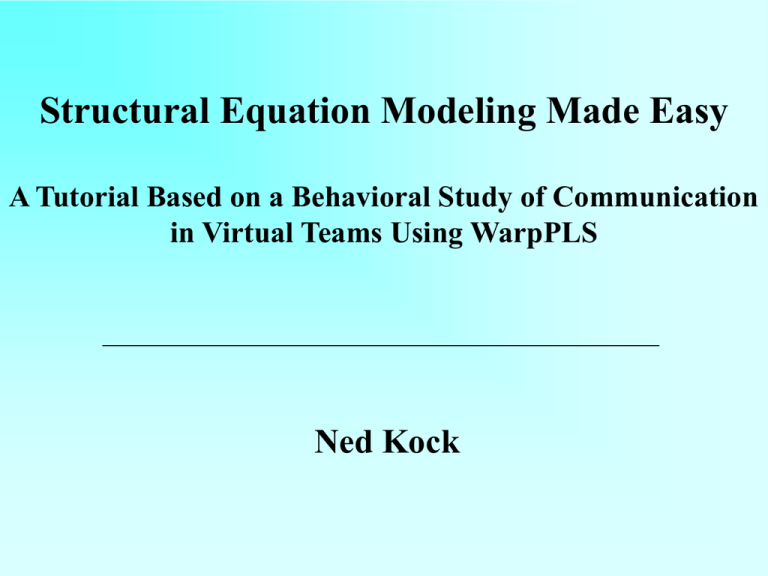
Structural Equation Modeling Made Easy A Tutorial Based on a Behavioral Study of Communication in Virtual Teams Using WarpPLS Ned Kock Outline of tutorial • 5-minute video clip (available from YouTube via WarpPLS.com). • Basic overview of structural equation modeling (SEM). • Study of communication in virtual teams using WarpPLS. • Overview of web resources on WarpPLS, including download site and blog. Note: Questions will be answered at any time during the tutorial. 5-minute video clip (available from YouTube via WarpPLS.com) Basic overview of structural equation modeling (SEM) Comparison of means model Criterion or dependent variable Predictor or independent variable commor easgen Note: Also testable through correlation analysis. Multiple ANOVAs Independent variable easund commor Dependent variables easgen comple Note: The test would be MANOVA if the impact of “commor” on the three dependent variables as a group was being assessed. Multiple regression Dependent variable easund commor easgen comple Independent variables Path analysis Intervening variable easund Independent variables Dependent variable easuse commor easgen comple SEM techniques • Structural equation modeling (SEM) techniques can be: – Covariance-based – e.g., those employed by the statistical software analysis tool called LISREL. – Variance-based – e.g., those employed in partial least squares (PLS) analysis. • SEM techniques are known as second generation data analysis techniques. • SEM allows for the modeling and testing of relationships among multiple independent and dependent constructs, all at once. Constructs, indicators and paths • Construct – This is a theoretical concept that is not directly measurable. Also known as latent variable. • Indicator – Is a measurable variable used to represent a construct (e.g., item on a questionnaire). Also referred to as manifest variable, item, and indicant. • Path – Is the link between constructs, or from construct to indicator. Also known as link, and often measured through a path coefficient. Path coefficient Path coefficient between Y and X = standardized partial regression of Y on X controlling for the effect of one (e.g., Z) or more variables. X Partial regression (standardized) of Y and X, controlling for Z. Y Mathematical formula Z Partial regression (standardized) of Y on Z, controlling for X. Diagrammatic representation Endogenous vs. exogenous • Exogenous construct – This is a construct that is independent of any other constructs. – No other constructs point at it in an SEM diagram. – Also known as exogenous latent variable. • Endogenous construct – This is a construct that depends on one or more other constructs. – Is pointed at by one or more constructs in an SEM diagram. – Also known as endogenous latent variable. SEM model components Exogenous construct (a.k.a. independent construct) Indicator Construct (a.k.a. latent variable) Path Path coefficient Endogenous construct (a.k.a. dependent construct) Interaction effect construct (a.k.a. moderating effect construct) Source: Chin (2001) Reflective measurement • In this form of construct measurement, paths connecting construct to indicators are directed towards the indicators. • The indicators are supposed to load strongly on the construct. • Such constructs are often designated as latent constructs (or reflective latent constructs). Formative measurement • In this form of construct measurement, paths connecting construct to indicators are directed towards the construct. • The indicators are not assumed to have to load strongly on the construct. • Such constructs are often designated as formative latent constructs. • Only variance-based SEM techniques (e.g., PLS) can deal with formative latent constructs. Study of communication in virtual teams using WarpPLS Participants • Contact persons in a variety of companies in the Northeastern USA were selected to participate in the study. • To be included in this study, each company must have developed a product that had been launched into the marketplace and commercialized for at least six months. • Data from 290 new product development (NPD) projects in 66 companies were obtained. Research instrument • A questionnaire developed based on previous research on NPD teams was used. • All constructs in the study were measured using multiple-item scales, which in turn were Likert-type scales (0 = “Strongly Disagree” to 10 = “Strongly Agree”). Constructs and measures Constructs and measures (cont.) Step 1: Create project file Step 2: Read raw data Step 3: Pre-process data Step 4: Define model Step 5: Perform analysis Overview of web resources on WarpPLS WarpPLS.com WarpPLS blog WarpPLS on YouTube Thank you!
